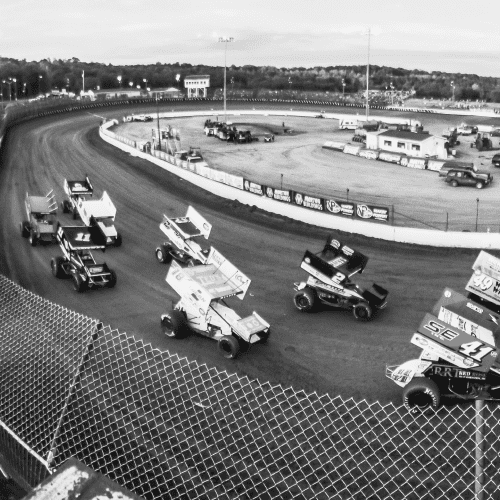

Just as important as the cars and the drivers who drive them, the track is the gauntlet laid down before drivers each race. Unlike our paved track racing brethren, a dirt track surface is dynamic, always changing throughout the night, and rarely the same from day to day, one might consider the track as a competitor itself in a way.
In dirt racing, the track configurations and composition vary across a wide spectrum. From ¼-mile Bullrings to ½-mile high-banked speedways, we’ll take a look at a few common configurations, and then take a look at the racing surface compositions.
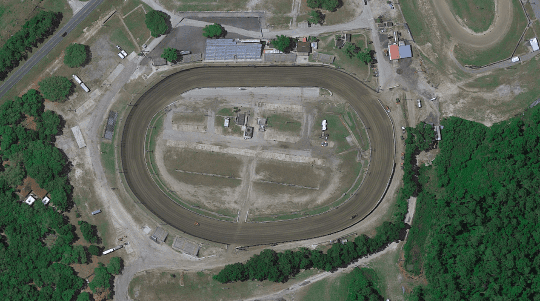
Example: Volusia Speedway Park (Barberville, FL)
A D-shaped race track is a type of oval racetrack that resembles the letter "D" when viewed from an aerial perspective. It is a variation of the traditional oval shape commonly used in motorsports:
As the name suggests, a D-shaped dirt track has a distinctive shape resembling the letter "D." It has a rounded straightaway on one side and a tighter, more curved turn on the other side.
D-shaped dirt tracks vary in size, but they generally feature a longer straightaway on the rounded side, followed by a tighter turn and shorter straightaway on the other side. The overall length of the track can vary greatly.
The track is often banked or sloped to allow drivers to maintain higher speeds while negotiating turns. The degree of banking can vary depending on the track and its specific design.
The tighter turn on the curved side of the D-shape is a crucial element of the track. It requires drivers to navigate the corner at a slower speed compared to the straightaway, making it a critical area for overtaking or defending positions.
Overall, attending a race at a D-shaped dirt track offers fans an immersive experience with thrilling racing action, close proximity to the track, unique viewing perspectives, fan interaction opportunities, and a vibrant atmosphere. It's an excellent way to enjoy the sport of dirt track racing while creating lasting memories.
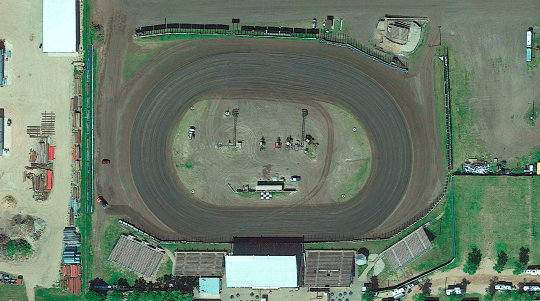
Example: River Cities Speedway (Grand Forks, ND)
This dirt racing staple is defined by its lack of straightaways and short length. These tracks tend to keep competitors close together, and when the leaders begin to catch the back of the field, the action really heats up. Known for being hard to pass on, and featuring close quarter “beating and banging” style of racing, Bullrings are a fan favorite across the country.
Bullring tracks are typically smaller in size compared to traditional oval tracks. They have a short overall length, usually less than half a mile, and tight turns, which results in a smaller racing surface.
Bullring tracks are oval in shape, but they have a distinct design that sets them apart from larger tracks. They often have a more circular or near-circular shape, with tighter turns and narrower straightaways.
Due to their smaller size, bullring tracks usually have high banking or steeply angled turns. The banking helps drivers maintain speed through the turns and allows for more aggressive racing maneuvers, such as side-by-side racing and frequent overtaking.
Bullring tracks are known for their intense and action-packed racing. The shorter length, tight turns, and high banking force drivers into close proximity, leading to more frequent contact and exciting racing maneuvers. The close-quarters racing often results in intense battles for position and a higher likelihood of collisions or spins.
Bullring tracks offer a unique spectator experience. Due to their smaller size, the audience is closer to the action, which enhances the overall viewing experience. Fans can witness the race unfold from various vantage points, often with excellent views of the entire track.
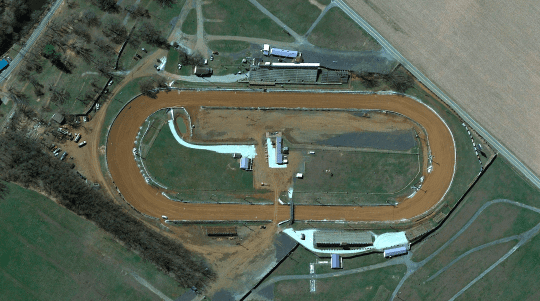
Example: Williams Grove Speedway (Mechanicsburg, PA)
Paperclip race tracks tend to be longer in length. Often between ⅜ and ½ mile, these tracks are notable for their long straightaways and tight corners. The long straightways allow drivers to carry a lot of momentum into the corners, but the tight circumference of the corner will often bring the cars back together. Position and handling is paramount on these tracks.
The turns on a paper clip oval track are usually tight and have a smaller radius compared to other oval tracks. This design requires drivers to slow down significantly and navigate the corners with precision.
The layout of a paper clip oval track demands efficient acceleration out of the tight turns and strong braking into them. Drivers need to strike a balance between carrying speed through the straightaways and maintaining control while decelerating for the corners.
The unique layout of a paper clip oval track often provides ample opportunities for overtaking. The contrasting turns and varying lengths of the straightaways allow drivers to set up passes and make strategic moves to gain positions.
Due to the sharp turns and varying straightaways, driving on a paper clip oval track requires technical skill and precise car control. Drivers must have a good understanding of racing lines, braking points, and throttle management to navigate the track efficiently.
The asymmetrical nature of the track layout presents strategic challenges for drivers and teams. Decisions such as choosing the preferred line through the corners, managing tire wear, and optimizing setup for both ends of the track become critical for success.
The combination of tight turns, varying straightaways, and overtaking opportunities often leads to close racing on a paper clip oval track. Drivers are frequently in close proximity, battling for position, which can make for exciting and intense racing action.
The fan experience at paperclip track can be quite engaging and thrilling. Spectators can feel the rumble of the engines, hear the sounds of screeching tires, and even catch glimpses of the drivers inside their cars as they navigate the corners. The fan experience at a paper clip oval dirt track often immerses spectators in the sights, sounds, and energy of the race.

Example: Huset’s Speedway (Brandon, SD)
High banked ovals tend to have steep sweeping corners and a decent length straightaways. Much like the Paper Clip, drivers can choose to run the top or bottom line, but with the high banking both lines can carry much more speed through the corners. These tracks tend to have a lot of passing and excitement as the lap times are very quick.
High-banked ovals have significantly elevated banking angles in the turns. The degree of banking can vary, but it typically ranges from 30 to 45 degrees or even higher. The steep banking helps drivers maintain higher speeds through the corners by utilizing the downward force generated by the banking.
The steep banking of a high-banked oval allows drivers to carry more speed through the turns. The banking assists in maintaining traction and grip, enabling drivers to take the corners at higher velocities compared to flatter tracks.
The steep banking, combined with the high speeds, generates intense centrifugal forces on the drivers. As they navigate the turns, they experience significant lateral G-forces pushing them towards the outer edge of the track. This requires drivers to have physical stamina and the ability to withstand the forces exerted on their bodies.
The high-banked configuration promotes aggressive and thrilling racing. The increased speeds and the ability to maintain momentum through the turns enable drivers to engage in side-by-side racing, overtaking opportunities, and close-quarters battles for position. This often results in exciting and intense racing action for both competitors and spectators.
The banking of the track affects the ideal racing line that drivers should take. They can choose different lines, from hugging the inside line at the bottom of the track to running higher up on the banking to carry more momentum. Finding the right racing line and mastering the nuances of the banking is crucial for success on high-banked oval dirt tracks.
High-banked ovals offer an exceptional viewing experience for spectators. The steep banking allows for great visibility from various seating locations around the track, providing fans with a clear view of the entire racing surface. It enhances the excitement of the races as spectators can witness the speed and intensity of the cars navigating the high-banked turns.
In dirt car racing, different types of dirt tracks can be found depending on the location and the specific type of racing. Here are some common types of dirt tracks used in dirt car racing:

Example: Attica Raceway Park (Attica, OH)
Clay tracks are one of the most common types of dirt tracks in racing. Clay is a mixture of fine particles of decomposed rock and sediment. It provides a smooth and high-grip surface, which allows drivers to maintain control of their vehicles while cornering and accelerating.
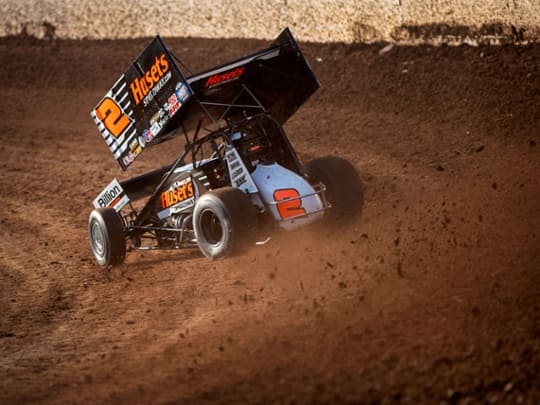
Example: Beaver Dam Raceway (Beaver Dam, WI)
Loam tracks consist of a balanced mixture of sand, silt, and clay. This type of dirt track offers good traction and is often preferred by racers as it allows for multiple racing lines and facilitates passing.
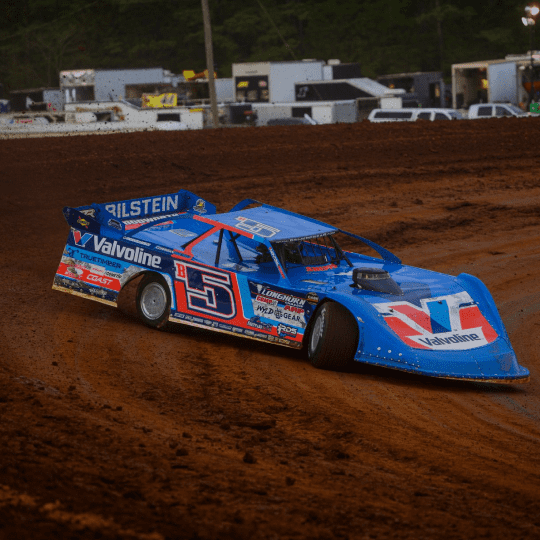
Example: Talladega Short Track (Eastaboga, AL)
Red dirt tracks, also known as red clay tracks, are prevalent in some regions. They derive their distinctive reddish color from the iron oxide present in the soil. Red dirt tracks can vary in texture and grip levels depending on the specific composition of the soil.

Example: Jackson Motorplex (Jackson, MN)
Gumbo dirt tracks are characterized by their dark-colored soil, which is rich in organic matter. This type of dirt track is often seen in agricultural areas where the soil has a high concentration of decomposed organic materials. Black dirt tracks can offer good grip and a smooth racing surface.
It's important to note that dirt tracks can be prepared and maintained differently by track officials, which can affect the characteristics of the racing surface. Factors such as moisture levels, track grooming techniques, and track preparation methods can all influence the traction and overall racing experience on a dirt track.
Preparing a dirt track for a race is an art form. With the variety of track surfaces across the country, and the divisions racing on them each night, one of the most important jobs in dirt racing is Track Prep. The track crew works tirelessly in the days leading into, and throughout the night of an event. Here’s a look at the tools and techniques used to make a safe and exciting dirt track surface.

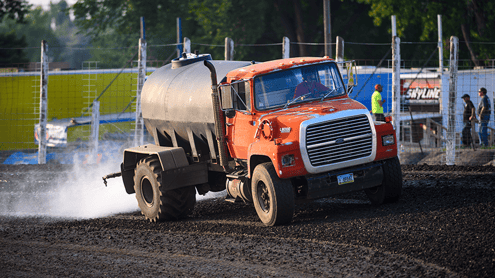
Moisture content is crucial for the track's condition. Watering the track thoroughly before race day ensures it is packed and compacted properly. The amount of water required depends on the track's composition and weather conditions. Too much water can make the surface muddy, while too little can make it dry and dusty.

Heavy machinery like rollers or compactors pack the track surface tightly. This helps to create a solid base and reduce loose dirt, providing better traction for the racers.
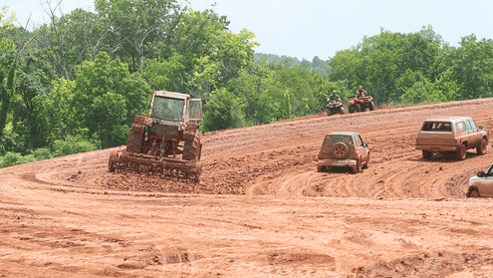
Shaping the track to provide optimal racing lines and define the turns. Banking the turns helps racers maintain speed and control through the corners. The degree of banking depends on the track's size and the type of racing.
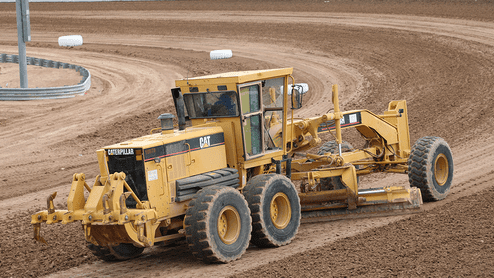
Use grading equipment to maintain an even and consistent surface. Regularly scrape the track to remove ruts, bumps, or excess loose dirt. This process can be done with a motor grader or specialized equipment like a box blade.
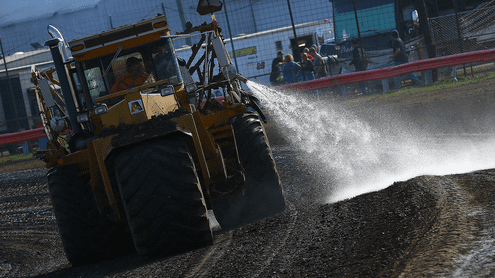 Monitoring the moisture content of the track throughout the race day is important. Crews adjust the watering schedule accordingly to maintain the ideal level of moisture. Too much or too little moisture can affect the track's consistency and racing conditions.
Monitoring the moisture content of the track throughout the race day is important. Crews adjust the watering schedule accordingly to maintain the ideal level of moisture. Too much or too little moisture can affect the track's consistency and racing conditions.
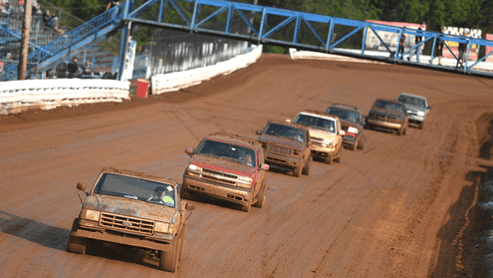
Between races or during breaks, use track packing equipment to keep the racing surface compacted and in optimal condition. This helps to minimize track deterioration and maintain a consistent surface for all competitors.
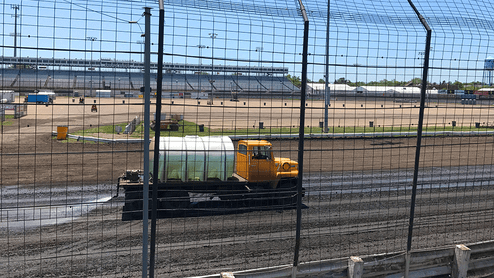
Dust can reduce visibility for drivers and spectators. Applying a dust control agent, such as calcium chloride or water with a binding agent, can help mitigate dust formation and improve overall race experience.
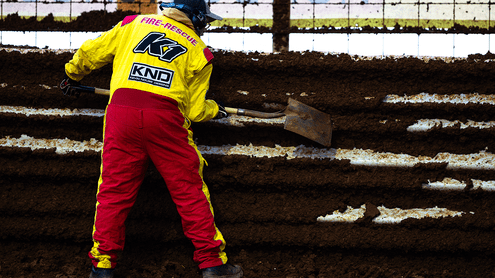
Throughout the night, dirt and mud will often cover the walls through the corners making it difficult for drivers to see. To help with this the track crew will occasionally scrap lines or chevrons in the dirt so drivers know just how far they can push the limits.
In dirt car racing, different types of dirt tracks can be found depending on the location and the specific type of racing. Here are some common types of dirt tracks used in dirt car racing:
The midway is the area — usually behind or near the grandstands — where various attractions, vendors, and activities are set up to entertain spectators when they first arrive and during breaks in the on-track action.
Some things you might find on the midway at a World of Outlaws Race:
Vendors line the midway, offering a variety of merchandise, souvenirs, and novelties for purchase. These may include T-shirts, hats, toys, collectibles, racing memorabilia, and other items related to the dirt track or the event.

Our Fan Engagement team will have a booth at every series event. You can sign up for our Be an Outlaw Fan Rewards Program, check in with your Digital Passport, and chat with the team about any questions you might have.
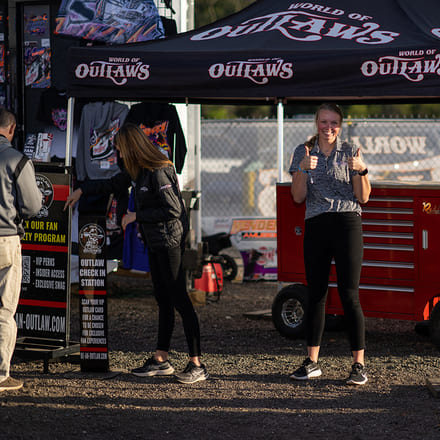
Midways are known for their wide selection of food and beverage options. You can find food like corn dogs, soft pretzles, and cheeseburgers. It’s also not rare to find a food truck or two at an event, as well as more substantial offerings like burgers, hot dogs, pizza, and BBQ.

Midways often have stages or designated areas for live entertainment. This can include musical performances, special live pre-race shows, and other forms of entertainment to keep the crowd engaged.

Midways strive to create a family-friendly environment, catering to people of all ages. The attractions and activities are designed to provide entertainment and enjoyment for children, teenagers, adults, and seniors alike.

Vendors line the midway, offering a variety of merchandise, souvenirs, and novelties for purchase. These may include T-shirts, hats, toys, collectibles, racing memorabilia, and other items related to the dirt track or the event.

Our Fan Engagement team will have a booth at every series event. You can sign up for our Be an Outlaw Fan Rewards Program, check in with your Digital Passport, and chat with the team about any questions you might have.

Midways are known for their wide selection of food and beverage options. You can find food like corn dogs, soft pretzles, and cheeseburgers. It’s also not rare to find a food truck or two at an event, as well as more substantial offerings like burgers, hot dogs, pizza, and BBQ.

Midways often have stages or designated areas for live entertainment. This can include musical performances, special live pre-race shows, and other forms of entertainment to keep the crowd engaged.

Midways strive to create a family-friendly environment, catering to people of all ages. The attractions and activities are designed to provide entertainment and enjoyment for children, teenagers, adults, and seniors alike.

Dirt track grandstands are the seating areas surrounding a dirt track or racetrack where spectators gather to watch the racing action.
Grandstands are typically built on raised platforms or tiers to provide spectators with an elevated vantage point. This allows for a better view of the entire track, ensuring that spectators can see the race from different angles.
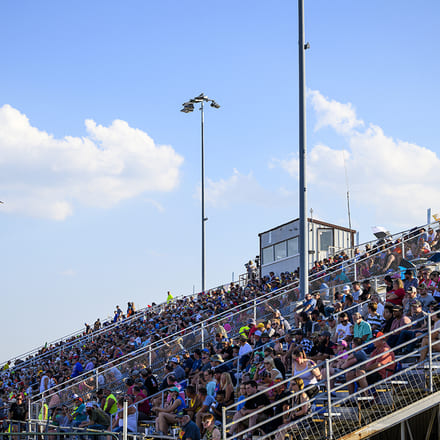
Grandstands can vary in size, ranging from small structures with a few rows of seating to larger grandstands that can accommodate thousands of spectators. The seating capacity depends on the size and popularity of the track.
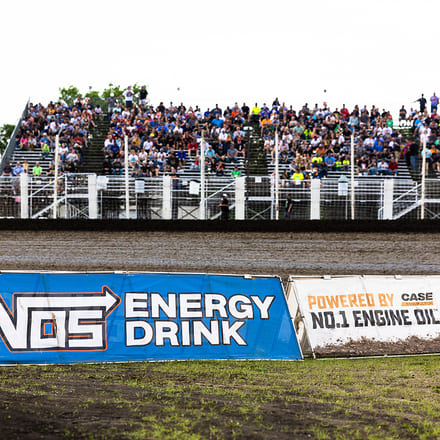
Most dirt track grandstands feature bleacher-style seating, which consists of rows of benches or individual seats without backs. This type of seating arrangement allows for maximizing the number of spectators in a limited space.

Grandstands prioritize spectator safety, so they are often equipped with safety features such as handrails, barriers, and fencing to prevent accidents and ensure crowd control. These measures help protect spectators from any potential hazards.
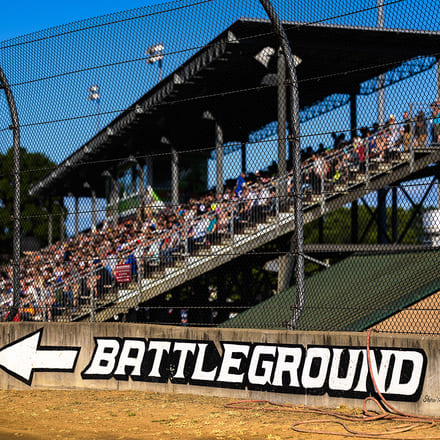
Dirt track grandstands strive to be accessible to a wide range of spectators. They often have ramps, staircases, and designated seating areas for individuals with disabilities, ensuring that everyone can enjoy the races comfortably.

Grandstands contribute to the energetic and lively atmosphere of dirt track racing. They are often filled with enthusiastic fans who cheer on their favorite drivers and engage in the overall excitement of the event. The atmosphere can be electric, especially during intense races or close finishes.

Grandstands are typically built on raised platforms or tiers to provide spectators with an elevated vantage point. This allows for a better view of the entire track, ensuring that spectators can see the race from different angles.

Grandstands can vary in size, ranging from small structures with a few rows of seating to larger grandstands that can accommodate thousands of spectators. The seating capacity depends on the size and popularity of the track.

Most dirt track grandstands feature bleacher-style seating, which consists of rows of benches or individual seats without backs. This type of seating arrangement allows for maximizing the number of spectators in a limited space.

Grandstands prioritize spectator safety, so they are often equipped with safety features such as handrails, barriers, and fencing to prevent accidents and ensure crowd control. These measures help protect spectators from any potential hazards.

Dirt track grandstands strive to be accessible to a wide range of spectators. They often have ramps, staircases, and designated seating areas for individuals with disabilities, ensuring that everyone can enjoy the races comfortably.

Grandstands contribute to the energetic and lively atmosphere of dirt track racing. They are often filled with enthusiastic fans who cheer on their favorite drivers and engage in the overall excitement of the event. The atmosphere can be electric, especially during intense races or close finishes.

At a dirt track, you will typically find different types of pit areas catering to specific needs during race events. Two of the most common are the Hot Pit and the Work Area.
Dirt track Hot Pits refer to the designated areas where race teams work on their vehicles and make necessary adjustments during race events.
Dirt track hot pits are typically located adjacent to the track, allowing easy access for race teams to bring their vehicles in for maintenance and repairs. The layout may consist of designated parking spaces or stalls for each team, with enough space to accommodate the vehicles, tools, and crew members.
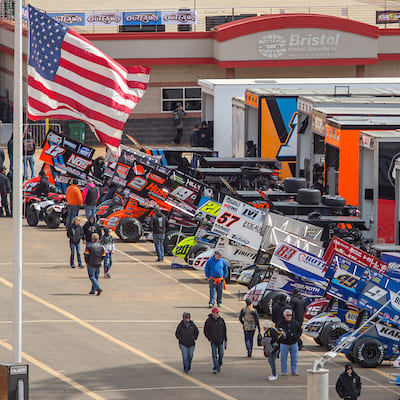
Access to the hot pits is restricted to authorized personnel, such as race team members, officials, and event staff. Pit passes or credentials are required to enter the pit area, ensuring that only those involved in the race operations are present.
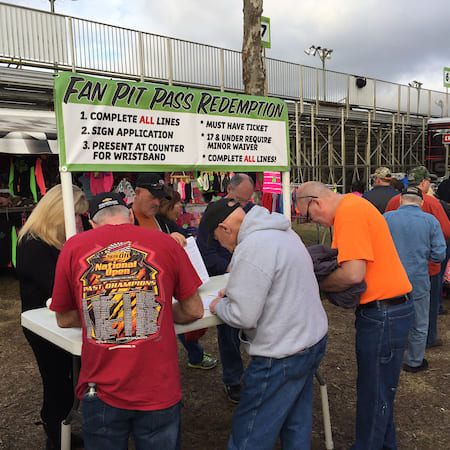
The hot pits are bustling with activity as pit crews work on the race cars. Pit crews consist of mechanics, technicians, and other team members responsible for maintenance, repairs, and adjustments. They bring a variety of tools, equipment, and spare parts to handle any necessary work efficiently.

To separate the hot pits from the spectator areas and maintain safety, there is usually a pit wall or boundary. This barrier helps prevent unauthorized access and ensures that the pit area remains secure during the race.

Pit crews are equipped with the necessary tools and equipment to quickly change tires and make adjustments as needed.

Dirt track hot pits are typically located adjacent to the track, allowing easy access for race teams to bring their vehicles in for maintenance and repairs. The layout may consist of designated parking spaces or stalls for each team, with enough space to accommodate the vehicles, tools, and crew members.

Access to the hot pits is restricted to authorized personnel, such as race team members, officials, and event staff. Pit passes or credentials are required to enter the pit area, ensuring that only those involved in the race operations are present.

The hot pits are bustling with activity as pit crews work on the race cars. Pit crews consist of mechanics, technicians, and other team members responsible for maintenance, repairs, and adjustments. They bring a variety of tools, equipment, and spare parts to handle any necessary work efficiently.

To separate the hot pits from the spectator areas and maintain safety, there is usually a pit wall or boundary. This barrier helps prevent unauthorized access and ensures that the pit area remains secure during the race.

Pit crews are equipped with the necessary tools and equipment to quickly change tires and make adjustments as needed.

A dirt track Work Area is a designated area within a dirt track facility where teams can perform more intensive work that may not be feasible to complete in the Hot Pit during race events.
Unique to dirt racing, it is not uncommon to see teams helping each other in the Work Area.
Here are some characteristics commonly associated with a dirt track Work Area:
The work area is typically larger and more spacious than the hot pits, allowing ample room for teams to work on their vehicles. It is equipped with various tools, equipment, and resources necessary for extensive repairs, adjustments, and modifications.
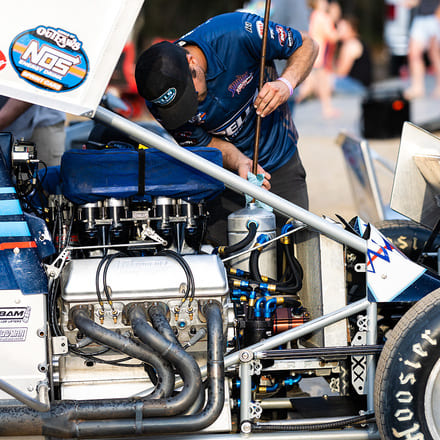
The work area is easily accessible, usually located near the hot pits or within close proximity to the track. This allows teams to transport their vehicles and equipment efficiently between the hot pits and the work area.
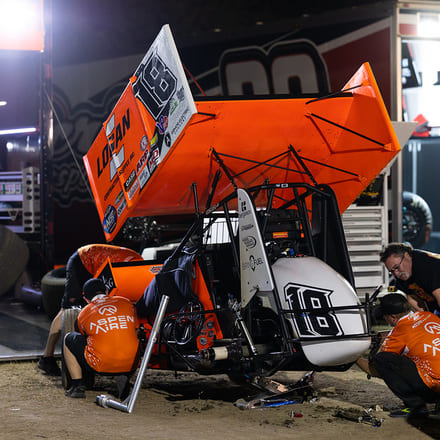
Unlike the hot pits, where quick maintenance tasks are performed during the race, the work area provides teams with extended time and flexibility to work on their vehicles. This allows for more comprehensive repairs, setups, and adjustments to be made.

The work area is equipped with specialized equipment and resources that facilitate more complex repairs and modifications. This may include tools for chassis adjustments, suspension setups, engine repairs, welding equipment, and other specialized machinery.
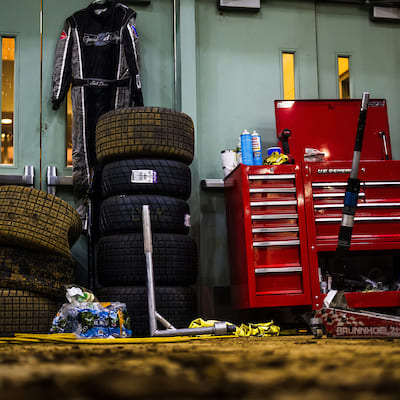
The work area is typically larger and more spacious than the hot pits, allowing ample room for teams to work on their vehicles. It is equipped with various tools, equipment, and resources necessary for extensive repairs, adjustments, and modifications.

The work area is easily accessible, usually located near the hot pits or within close proximity to the track. This allows teams to transport their vehicles and equipment efficiently between the hot pits and the work area.

Unlike the hot pits, where quick maintenance tasks are performed during the race, the work area provides teams with extended time and flexibility to work on their vehicles. This allows for more comprehensive repairs, setups, and adjustments to be made.

The work area is equipped with specialized equipment and resources that facilitate more complex repairs and modifications. This may include tools for chassis adjustments, suspension setups, engine repairs, welding equipment, and other specialized machinery.


From retaining walls to catch fences, every track on the World of Outlaws tour undergoes a full inspection. Series and track officials work together to ensure the safety of all participants and spectators.
